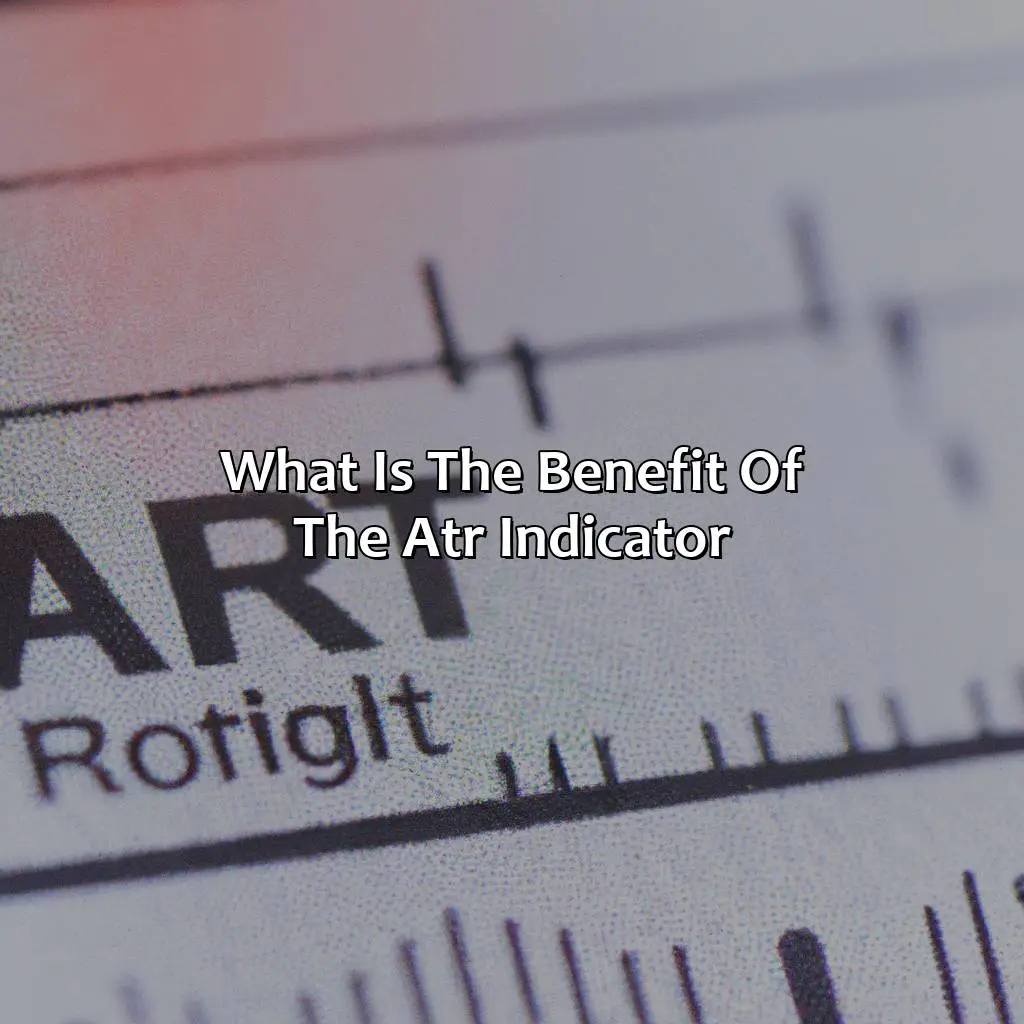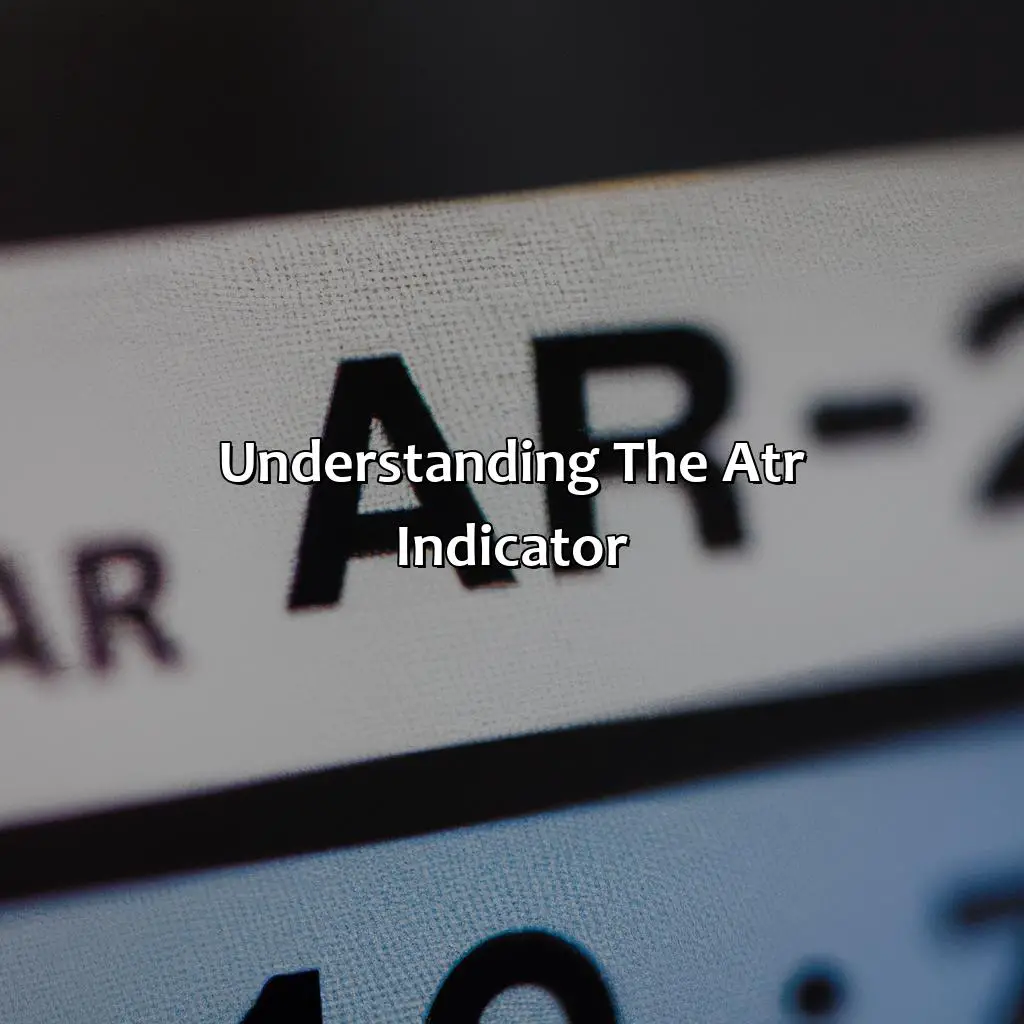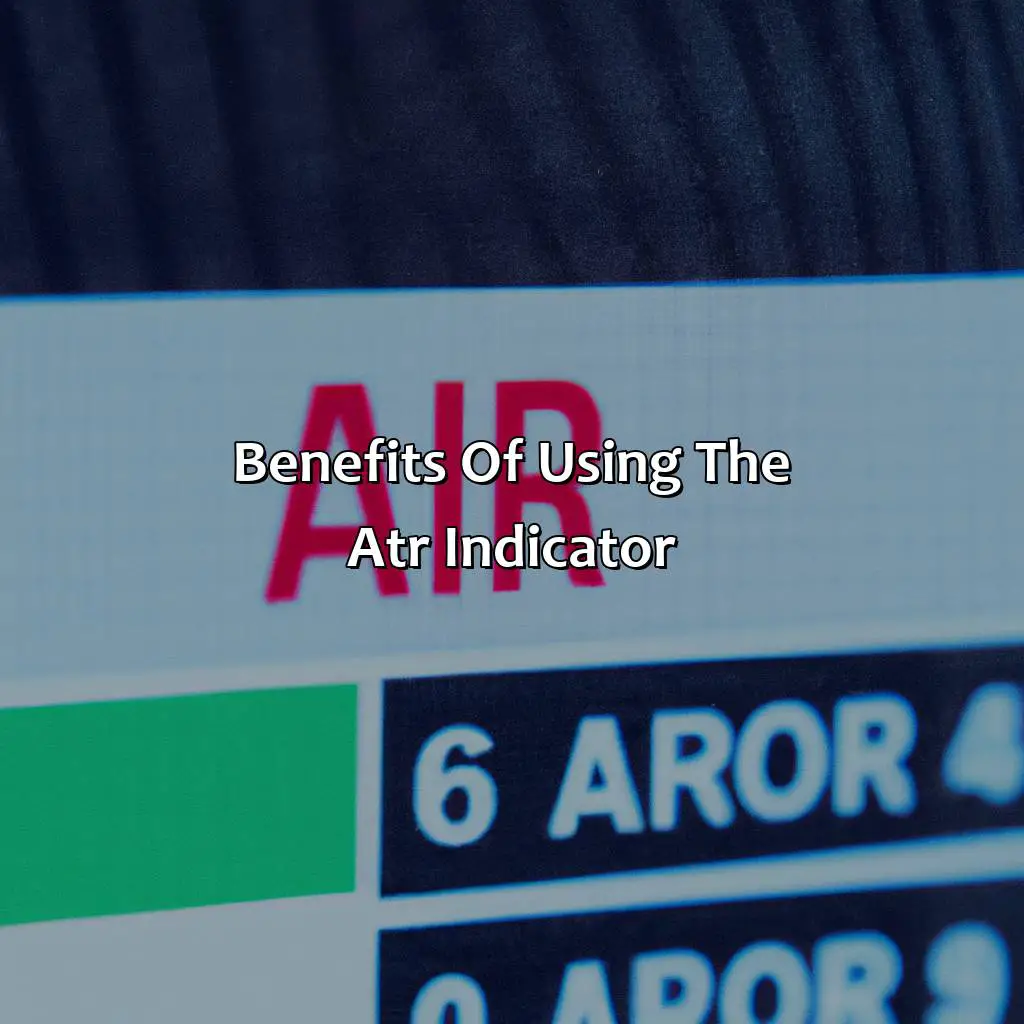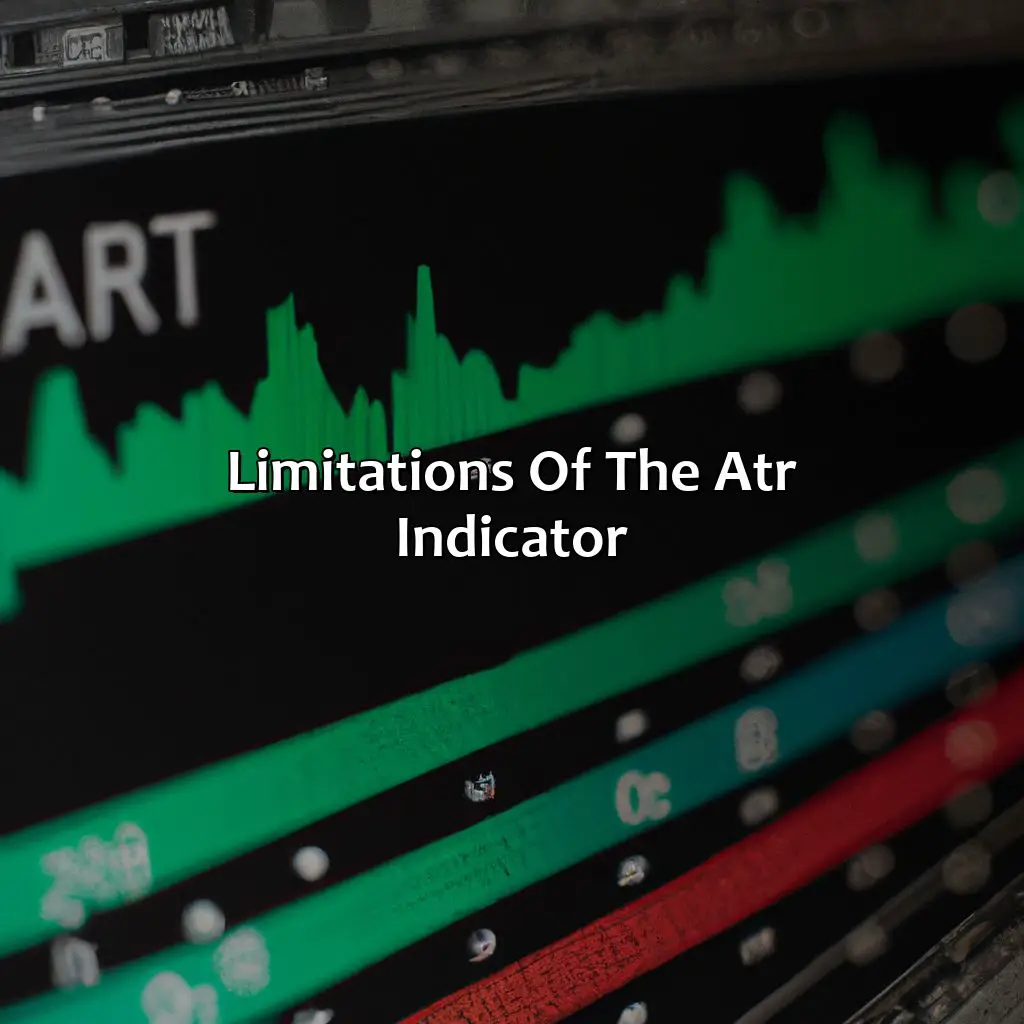
Key Takeaway:
- Using the ATR indicator can help measure market volatility and assist in managing risk by setting stop loss levels, identifying potential support and resistance levels, and analyzing the risk to reward ratio.
- The ATR indicator facilitates in identifying trend reversals and breakouts, making it a useful tool for trend analysis and trading decision-making.
- However, it is important to be aware of the limitations of the ATR indicator and not rely solely on it for trading signals or momentum, as it may not be useful for all trading styles and over-reliance on it may lead to losses.
Understanding the ATR indicator

Photo Credits: forexbrokerreport.com by Kyle Wilson
Gain better insights into market trends using the ATR indicator. It maximizes understanding of volatility and price movements. Discover its importance! This section explains what the ATR indicator is and why it is so vital.
Explanation of the ATR indicator
ATR indicator is a technical analysis tool used for measuring volatility in the financial markets. It was developed by J. Welles Wilder Jr. in the 1970s to provide a measure of price movement strength. The ATR stands for Average True Range, which is calculated by averaging the true ranges of the previous trading sessions. True range is calculated as a maximum difference between high and low prices during any market period.
This indicator is widely used to predict future volatility trends, set stop-loss levels, identify potential support and resistance levels, and analyze risk-to-reward ratios. The ATR indicator is especially useful in identifying potential trend reversals and breakouts.
The ATR indicator is an essential tool for traders who rely on technical analysis to make informed trading decisions. By understanding the range of potential price movements, traders can adjust their strategies accordingly.
A trader can easily add the ATR indicator to their charting software by selecting it from the list of indicators available on most platforms. Once added, there are several strategies that traders can use with the ATR indicator to improve their trading results.
While it is a powerful tool, it does have some limitations. Not all trading styles may benefit from using this indicator as it may not be suited for certain strategies. Moreover, over-reliance on this one tool could potentially lead to losses.
ATR indicator: because guessing market volatility is like playing pin the tail on the donkey.
Importance of the ATR indicator
The ATR indicator is of utmost importance to traders as it enables them to measure market volatility. This knowledge is crucial in assessing the risk and reward potential of opening a position. With this insight, they can arrive at a decision on whether it’s worth entering into a trade or not.
ATR measures the average range of price movements which occur over a certain period, which subsequently allows traders to adapt their strategies according to the price volatility or lack thereof.
Through the use of ATR, several benefits become accessible including:
- Setting stop loss levels
- Identifying potential support and resistance levels
- Trend reversals and breakouts in a market
- Analyzing risk-to-reward ratios before entering trades
While using ATR as an indicator in trading strategies has many pros, there are limitations that ATR may not be useful for all trading styles; neither should they pivot on this alone.
Get ahead in the trading game by utilizing the versatile ATR indicator to manage risk, identify trends and market conditions, and generate effective trading signals.
Benefits of using the ATR indicator

Photo Credits: forexbrokerreport.com by Matthew Garcia
To grasp the advantages of using the ATR (Average True Range) indicator in financial trading risk management, you should know it is a popular tool. It can provide trading signals and market analysis. The ATR measures market volatility and finds potential support and resistance levels. It also helps set stop loss levels, determine trend reversals, and spot breakouts. Plus, it can analyze risk to reward ratio for trading strategy, market trends, and market behavior.
Helps in measuring market volatility
The ATR indicator is highly effective when it comes to measuring market volatility as it primarily helps in understanding the price action of a particular security or an entire index. By using the ATR indicator, traders can measure how much a security has moved on average over a given period, providing them with crucial information that can help in making informed decisions.
Analyzing historical prices and comparing them with current volatility levels, one can gauge how significant the price changes are and if they are likely to persist. This ability to measure market volatility through the ATR indicator gives traders an edge in their trading strategy, allowing them to assess potential gains and losses while factoring in risks.
By monitoring price fluctuations using the ATR indicator, traders can gain valuable insights into a security’s behavior patterns, predicting price movements and identifying potential buying opportunities more accurately. Moreover, utilizing this method offers a greater level of objectivity than relying solely on intuition or gut feeling.
To optimize the use of ATR indicators for measuring market volatility, one should keep track of multiple stocks from different industries and compare their values based on recent trends. Additionally, it’s critical to use alternative metrics alongside the ATR indicator as no single method enables comprehensive assessment across all asset classes.
Set your stop losses with confidence, thanks to the ATR indicator’s valuable insights.
Aids in setting stop loss levels
The ATR indicator is useful in aiding traders to set stop loss levels. This is because the ATR can provide a better understanding of how much price movement can be expected, allowing for proper risk management and minimizing losses.
- To use the ATR indicator for setting stop loss levels, identify the current ATR value.
- Determine the market volatility based on whether the value is high or low.
- Set the stop loss level based on the market volatility and personal risk tolerance.
- Adjust the stop loss level if there are any changes in market conditions.
- Monitor and re-adjust stop loss levels regularly to ensure they remain appropriate.
It is important to note that while using the ATR indicator can help with setting stop loss levels, it should not be solely relied upon as a trading decision-making tool.
Traders should also consider other factors such as overall market trends and technical analysis before deciding on a trade placement strategy.
It has been reported by Investopedia that adapting trading strategies based on unique markets requires caution, expertise, discipline, and attention from traders.
Finding support and resistance levels just got easier with the ATR indicator on your side.
Helps in identifying potential support and resistance levels
Identifying potential support and resistance levels is a crucial aspect of trading, as it aids in making profitable decisions. The ATR indicator helps traders identify these levels with ease.
The ATR indicator provides valuable information to traders that aids in identifying potential support and resistance levels. It calculates the average true range of price movement over a specified period, providing insights into how much the asset’s price has fluctuated. Traders may then use this information to determine where support and resistance may lie.
To better comprehend the impact of the ATR indicator in identifying potential support and resistance levels, consider the following table:
| Currency Pair | Close Price | True Range |
|---|---|---|
| EUR/USD | $1.2015 | 0.0053 |
| GBP/USD | $1.3685 | 0.0094 |
| USD/JPY | ¥105.15 | 0.1405 |
| AUD/USD | $0.7822 | 0.0047 |
The column for True Range indicates how much each currency pair fluctuated over a predetermined period, helping traders identify patterns by recognizing significant high or low values.
Additionally, traders can utilize the Average True Range (ATR) to define appropriate stop-loss levels, allowing them to manage risk more effectively, which is necessary when analyzing potential support and resistance levels using ATR Indicator.
While understanding how ATR helps in identifying potential support and resistance levels is essential to successful trading, it is important not to rely too heavily on it alone; doing so can lead to missed opportunities or significant losses.
Consider an example in which you have used the ATR indicator consistently for a specific currency pair. Suppose you intended to sell at a presumed level of resistance but failed to notice additional crucial technical analysis signals indicating that it was not optimal to sell yet; you may end up missing a significant opportunity on that currency pair. Therefore, it’s important to align any decision with fundamental and technical analysis.
ATR indicator: The ultimate wingman to help you catch trend reversals and breakouts.
Facilitates in identifying trend reversals and breakouts
Facilitating the Identification of Trend Reversals and Breakouts
The ATR indicator is a crucial tool for traders as it assists in identifying potential trend reversals and breakouts. This results from calculating the average true range, which measures market volatility. Here are three ways that the ATR indicator can facilitate trend reversal and breakout identification.
- One of the most significant benefits of using the ATR indicator is that it enables traders to identify overbought or oversold conditions based on market volatility. A sudden increase in volatility may indicate a trend reversal or breakout, allowing traders to adjust their positions accordingly.
- Another way that the ATR indicator aids in identifying trend reversals is by noticing changes in momentum. If a security’s price moves quickly through its resistance level, traders may consider this a bullish signal if accompanied by high volume and increasing volatility.
- Finally, when using the ATR indicator alongside other technical analysis tools such as Moving Averages or Ichimoku Clouds, traders can identify key levels of support and resistance where reversals are likely to occur. By looking for these levels with high volatility signals, traders can gauge significant trend movement opportunities.
Additionally, identifying potential trend reversals and breakouts using the ATR indicator also assists in analyzing risk-reward ratios of investment decisions. However, relying solely on this single tool to make trading decisions might not be suitable for all trading styles.
To get maximum benefit from the ATR indicator when identifying potential trend reversals and breakouts, we suggest incorporating it into broader technical analysis strategies or adding additional indicators to confirm entry or exit points. Alternatively, you could use statistical models such as Regression Analysis or Monte Carlo Simulation to help predict future trends accurately.
Using the ATR indicator helps you weigh the risks and rewards of your trades like a pro.
Helps in analyzing the risk to reward ratio
Analyzing the risk to reward ratio is crucial in making informed trading decisions. The ATR indicator handles this task effectively by measuring market volatility and providing accurate calculations. It aids in ascertaining potential profit from a trade against the possible loss, giving traders a clear idea of the value of taking the risk.
By utilizing ATR, traders can have increased confidence in their trading strategy and avoid emotional decision-making. The greater the risk to reward ratio, the higher are the opportunities for profits and vice versa. Therefore, analyzing the risk to reward ratio through ATR can lead to increased profits while minimizing losses.
Using different values of ATR over short or long term periods allows traders to observe trading patterns, enabling better prediction of market behavior. Thus, analysis of the risk-reward ratio using ATR indicators offers a measurable criterion that helps determine the optimal level of profit target and stop-loss levels.
Although relying solely on ATR may not be sufficient for some trading styles, it remains an important tool for assessing risk-to-reward ratios. Over-reliance on any technical tool could lead to poor decision-making that results in significant financial losses. Therefore, it is essential to use this indicator wisely while adhering to good money management practices.
A professional trader once shared how using ATR helped him analyze his trades meticulously, leading to greater profits while minimizing risks. Observing each trade’s volatility helped him establish ideal entry points while factoring variables like leverage and position sizing quickly. Additionally, he highlighted that monitoring both trendlines alongside market volatility through ATR offered an edge needed in profitable trading activities.
Maximize trading opportunities by using the ATR indicator to analyze market movements, chart patterns, and fluctuations in market volatility.
How to use the ATR indicator

Photo Credits: forexbrokerreport.com by Andrew Scott
To use the ATR indicator, with momentum and chart patterns, for spotting trading opportunities, you need to learn some key techniques. In this section, we’ll uncover insights on the benefits of technical analysis tools like the ATR indicator. We’ll dive into strategies for trend following and price action. We’ll use moving averages, support, resistance, and price levels. You’ll learn how to add the ATR indicator and develop trading plans with market news, technical charts, and approaches. Also, we’ll explore market research and analysis techniques, such as trend strength, market prediction, and forecasting.
This will help with trade management and financial analysis.
Steps to add the ATR indicator in trading platforms
To add the ATR indicator in trading platforms, users must follow simple steps which are easy to understand and perform. Here is a guide on how to do so:
- Open the trading platform.
- Select the ‘Indicators‘ option from the toolbar menu.
- Search for ‘ATR Indicator’ within the list of indicators displayed.
- Select ‘ATR Indicator‘ to open its configuration window.
- Configure the ATR settings as per your requirement, then click on ‘Ok.’ The ATR indicator is now added to your trading chart.
It’s essential to note that every trading platform has a different process when adding indicators. Therefore, users should ensure they refer to their platform’s user manual or seek a professional’s assistance when learning how to incorporate the ATR indicator into their chosen format.
A crucial aspect of adding an ATR indicator is understanding what it does and how it will fit into your overall strategy. Traders can use this tool in multiple ways as it provides invaluable data about market volatility and can help identify potential support and resistance levels, trend reversals, and breakouts.
Pro Tip: Experiment with different settings available within the ATR indicator on your chosen platform to ensure that you get accurate results for your chosen strategy.
Maximize your trades with the ATR indicator by using it to set precise stop loss levels and identify potential support and resistance.
Strategies for using the ATR indicator for trading decisions
The ATR indicator provides valuable information that helps in formulating trading strategies. Here are 5 strategies for using the ATR indicator to make effective trading decisions:
- Volatility-Based Stop Loss – A higher ATR value implies a higher level of volatility and accordingly, a wider stop loss limit should be set.
- Trend Confirmation – The degree of market volatility can help confirm the existence of a particular trend. For example, a continuous downtrend with high volatility may indicate a bearish market trend.
- Trading Range Breakout – An increase in ATR levels often precedes a potential breakout from an existing trading range.
- Determine Optimal Position Size – By considering the amount you’re willing to risk per trade relative to the distance between your entry point and your stop loss position, you can effectively decide on the ideal position size before entering the market.
- Identifying Specific Investment Opportunities – High levels of volatility suggest potential investments, but also involve risk. Financial instruments such as options or warrant contracts may offer an opportunity to benefit from such situations while minimizing downside risks.
In addition to these strategies, it’s important not to over-rely on this indicator alone and incorporate additional indicators for qualitative analysis.
To gain maximum benefits from using the ATR indicator, traders must stay up-to-date with changes and ensure that they evaluate historical data before making trades.
Don’t miss out on opportunities that could significantly boost profits. Incorporate these ATR-based trading strategies into your overall approach today! Don’t rely solely on the ATR indicator for market signals, momentum, or chart patterns; it’s like using a toothpick for a construction project.
Limitations of the ATR indicator

Photo Credits: forexbrokerreport.com by Noah Sanchez
Be aware of the drawbacks when using the ATR indicator for market signals and momentum analysis. To counter these limitations, chart patterns validation should be used. Remember the sub-sections ‘May not be useful for all trading styles‘ and ‘Over-reliance on the ATR indicator may lead to losses‘ when learning the benefit of the ATR indicator.
May not be useful for all trading styles
Limitations of the ATR indicator depend on the trading style. The ATR only measures market volatility and does not predict future price movements. Thus, if the trader’s strategy relies on predicting future prices with technical indicators, using the ATR may not be useful for all trading styles.
The ATR indicator is effective in measuring market volatility, but it cannot facilitate trading decisions alone for strategies that go beyond measuring volatility. For instance, a momentum or trend following trader relies primarily on moving averages or RSI indicators. Therefore, using ATR as a standalone tool may not suit their trading style.
However, the ATR can complement other tools to form a part of a comprehensive trading plan. Traders can use several indicators together to develop research-based and effective risk management tools specific to their trading styles where they cater to market trends instead of volume.
Putting all your faith in the ATR indicator is like relying on a GPS in a maze – it may lead you in circles and ultimately to a dead end.
Over-reliance on the ATR indicator may lead to losses
Relying solely on the ATR indicator may lead to financial losses. Although it is a useful tool for measuring market volatility, setting stop loss levels, and analyzing risk-to-reward ratios, it should not be the only factor in making trading decisions. It’s important to consider other technical and fundamental indicators before entering or exiting trades.
Over-analyzing ATR values might also lead to a stagnant approach, where traders incorrectly use ATR signals without considering different market conditions. Traders should have a holistic approach while integrating technical indicators with other market analysis tools.
Incorporating diverse factors into trade decision-making gives traders a better chance of accurately predicting market turns and making informed moves. Building a substantial trading plan that includes multiple inputs will reduce the risks associated with over-dependency on any particular indicator.
Never miss out on learning new techniques or strategies from other successful traders who are using various tools to predict market behaviour.
Over-reliance on the ATR indicator may lead to losses due to incomplete analyses and poor trade decisions; hence combining various elements results in achieving fruitful outcomes.
Some Facts About the Benefit of the ATR Indicator:
- ✅ The ATR indicator helps traders identify market volatility and potential price movements. (Source: Investopedia)
- ✅ The ATR indicator can be used to set stop-loss orders and determine position sizing. (Source: TradingView)
- ✅ The ATR indicator was developed by J. Welles Wilder Jr. and first introduced in his book “New Concepts in Technical Trading Systems.” (Source: BabyPips)
- ✅ The ATR indicator works well in combination with other technical analysis tools, such as moving averages and candlestick patterns. (Source: Day Trading)
- ✅ The ATR indicator can be customized to suit a trader’s individual preferences and trading style. (Source: Admiral Markets)
FAQs about What Is The Benefit Of The Atr Indicator?
What is the benefit of the ATR indicator?
The ATR indicator, or Average True Range indicator, is a powerful tool for traders that helps measure market volatility and potential risk. By understanding the ATR, traders can make more informed decisions regarding trade entries, stop losses, and profit targets.
How is the ATR indicator calculated?
The ATR indicator is calculated by taking the average of the True Range (TR) values over a particular period of time. The True Range is calculated by finding the maximum of the following three values: current High minus current Low, the absolute value of the current High minus the previous Close, and the absolute value of the current Low minus the previous Close. The ATR indicator takes into account market volatility, which is why it can be such a useful tool for traders.
What timeframes is the ATR indicator useful for?
The ATR indicator can be useful for any timeframe, from short-term trades to long-term investments. The timeframe that a trader chooses to use will depend on their trading strategy and goals. Traders should keep in mind that the ATR value will change depending on the timeframe they choose, with shorter timeframes generally producing higher ATR values.
How can the ATR indicator be used to set stop losses?
Traders can use the ATR indicator to help determine where to set stop losses. By multiplying the current ATR value by a certain multiple (such as 2 or 3), traders can set their stop loss at a distance from their entry point that takes into account recent market volatility.
Can the ATR indicator be used in conjunction with other indicators?
Yes, the ATR indicator can be used in conjunction with other indicators to help confirm trading signals. For example, traders may look for a breakout in price in combination with a high ATR value as confirmation of a potential trend reversal.
Is the ATR indicator advanced or beginner friendly?
The ATR indicator is considered an intermediate to advanced tool. While it can be used by beginners, it is important to have a basic understanding of market volatility and risk management before attempting to use the ATR as a trading tool. Traders should take the time to thoroughly study the ATR indicator and its applications before incorporating it into their trading strategy.


